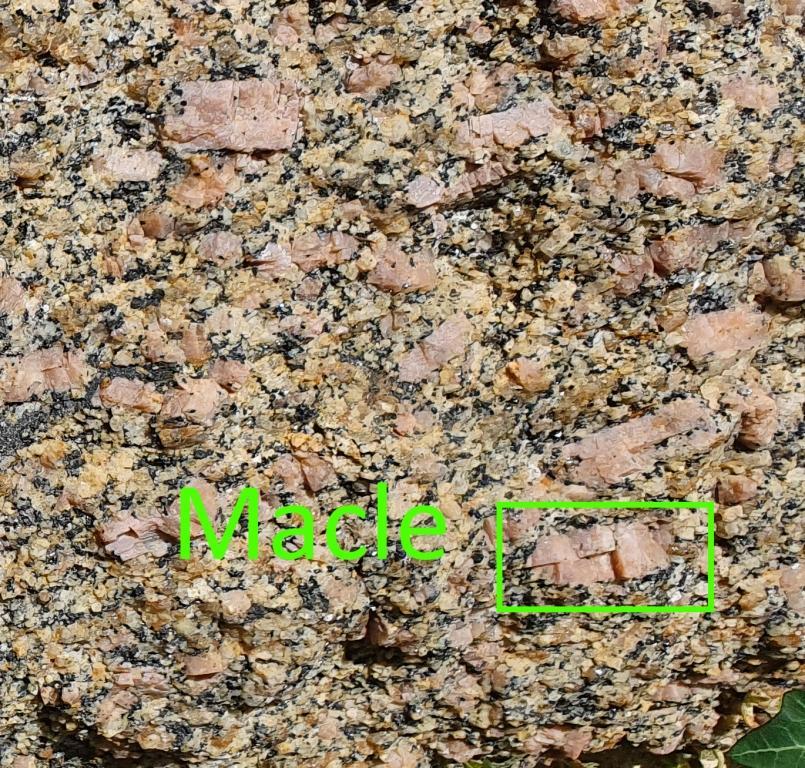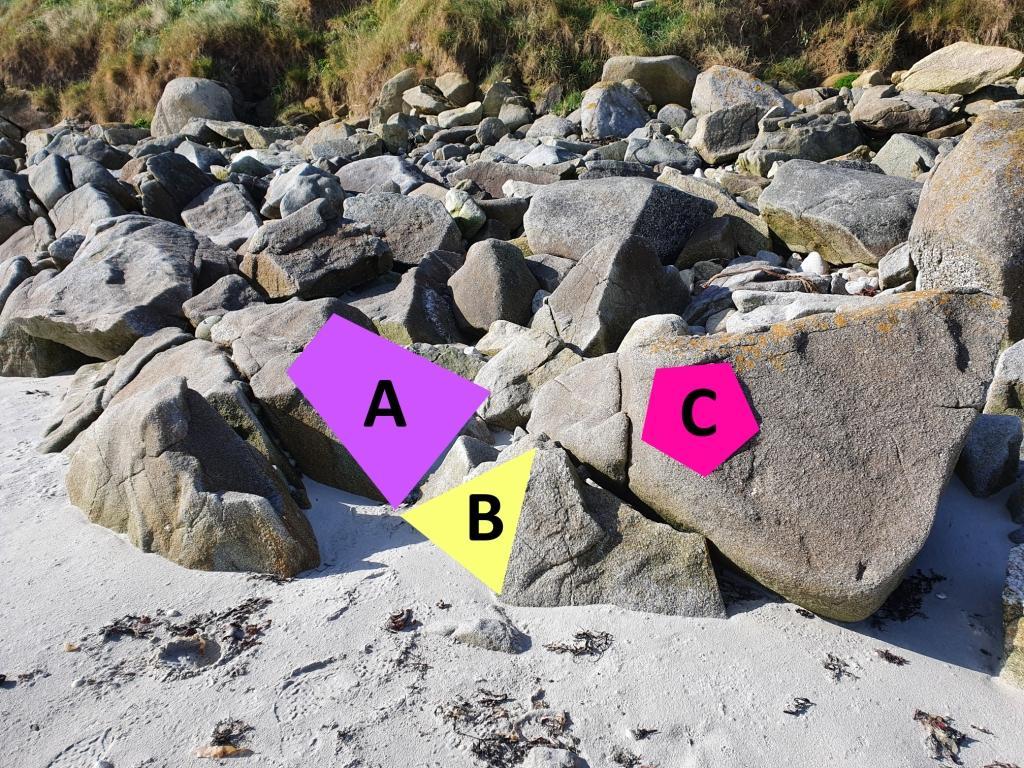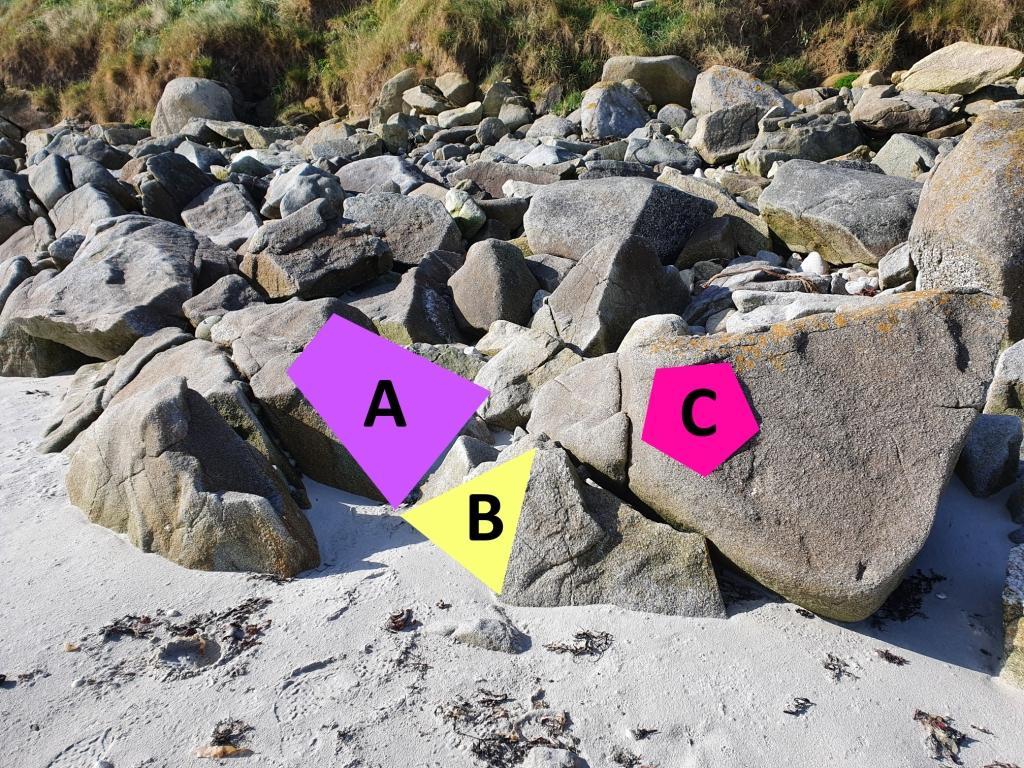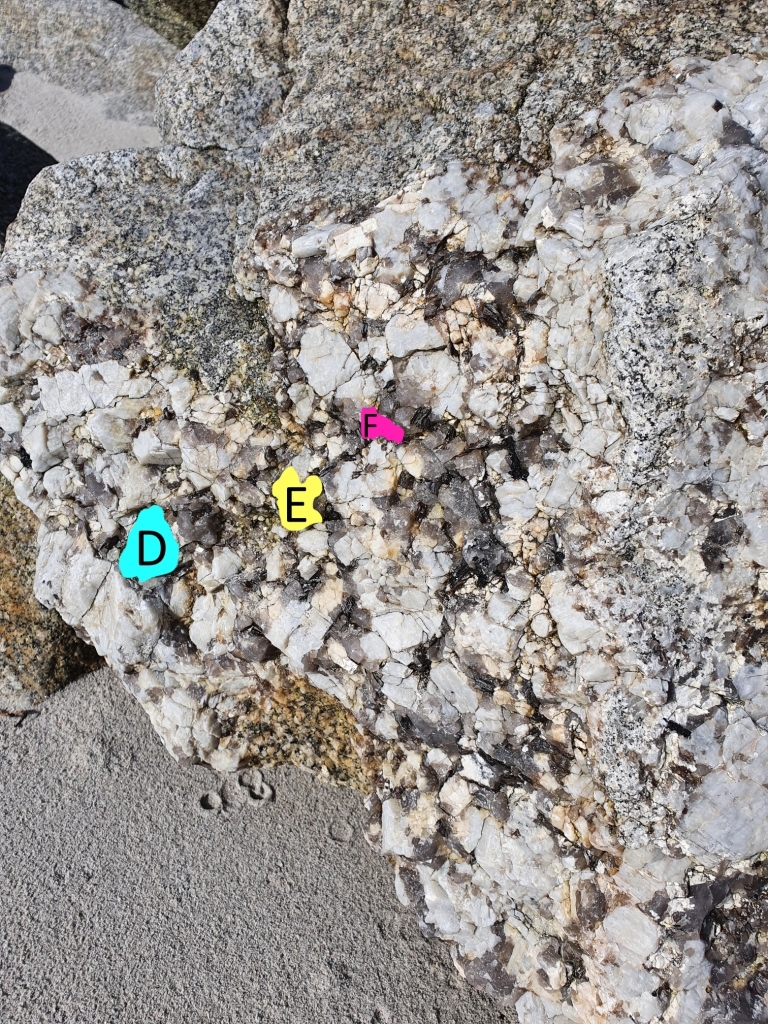Attention cette Earthcache est accessible à marée basse. Les horaires des marées sont ici. L’accès se fait par la plage.
Il s'agit d'une Earthcache, il n'y a pas de récipient à chercher.
Vous vous engagez de votre propre initiative dans la recherche de cette cache à vos risques et périls. Je décline donc toute responsabilité en cas de problème.
Pegmatite à l’île de Batz
Granite de l’île de Batz
L’île de Batz est essentiellement constituée par un granite de teinte gris clair. Le grain est généralement fin mais il peut être légèrement porphyrique (c’est-à-dire avec des cristaux de feldspaths un peu plus grands que les autres, de l’ordre du centimètre). Certains faciès montrent essentiellement de la biotite, d’autres sont nettement à deux micas. Ainsi, selon la texture et la composition minéralogique, les variétés observées sont nombreuses pour un œil attentif. Le granite est très régulièrement recoupé pas des veines de pegmatites (grain plus gros, roche plus claire) à tourmaline (minéral noir en baguette), ce qui lui donne une image très caractéristique qui ne peut échapper au visiteur, dès les affleurements du littoral au débarcadère.
Le granite de l’île de Batz appartient au massif de Roscoff dont il constitue la bordure nord. Le granite est issu de la cristallisation en profondeur d’un magma qui a pour origine la fusion de la base de la croûte continentale vers 700°C et environ 100 km de profondeur. Sa mise en place est en relation avec l’orogenèse hercynienne, il y a environ 320 millions d’années, à la fin des temps primaires (ou Paléozoïque) qui a vu s’édifier une vaste chaîne de montagnes sur une grande partie de ce qui est aujourd’hui l’Europe. La Bretagne se situait alors au sein d’un vaste continent, à peu près au niveau de l’Equateur. Ce continent s’est ensuite disloqué tandis que l’Océan Atlantique s’ouvrait et que la Bretagne dérivait vers le nord. Depuis, durant des millions d’années, l’érosion a nivelé ces montagnes et porté le granite à l’affleurement sous des climats chauds et humides qui ont favorisé l’altération des roches. Plus récemment, l’érosion a dégagé les produits de cette altération, laissant les blocs de granite, rochers, îlots qui constituent le paysage de l’île et celui d’une grande partie du littoral du nord-Finistère, sur terre comme en mer, sur la plateforme à écueils due à un ennoyage marin.
A l’île de Batz on trouve de nombreuses occurrences de minéraux pegmatitiques-pneumatolytiques : tourmaline, béryls... Ces occurrences sont en relation avec l’évolution tardive du massif granitique du Plouescat-Roscoff.

Aplites et Pegmatites
Les pegmatites et les aplites forment des filons (poches ou veines), en bordure ou au voisinage immédiat des plutons granitiques auxquels elles sont génétiquement associées (elles ont une composition voisine). Elles correspondent généralement au liquide résiduel, riche en eau, de fin de cristallisation d'un magma granitique (jus résiduel siliceux). Il est leucocrate (teinte claire), car les minéraux sombres (ferromagnésiens) comme la biotite ont une température de fusion (et donc de cristallisation) beaucoup plus élevé (850 degrés) que les minéraux siliceux (quartz et feldspaths), donc il n'y en pas dans les jus résiduels qui sont les derniers à se solidifier. Dans le jus résiduel siliceux se concentrent des éléments rares dits "incompatibles" (B, Be, Nb, Ta, etc...)
Pegmatite
En dehors de la différence de teinte leucocrate, la pegmatite se caractérise par la taille des cristaux qui la constituent. Leur taille est beaucoup plus grande que la taille des cristaux du granite voisin. En général plus la taille des cristaux est grande plus le refroidissement du magma était long. Ici du fait de la présence des éléments fondants (certains éléments rares) qui abaissent le point de fusion, la viscosité du magma, et le taux de nucléation, le filon lié à l'intrusion magmatique représente une phase pegmatitique (entre 800° et 600°) qui voit l'augmentation du taux de croissance des cristaux et un temps de refroidissement qui n'a pas besoin d'être très long.
Vitesse de cristallisation
Rappelons qu'aplites et pegmatites sont des roches magmatiques essentiellement filoniennes, à petits cristaux (plus petits que ceux d'un granite classique) pour les aplites, et à gros cristaux (plus gros que ceux d'un granite classique) pour les pegmatites. Si la petite taille des cristaux d'aplite est sans doute due à une cristallisation rapide, ce qui est normal dans un filon étroit qui se refroidit vite, la grande taille des cristaux des pegmatites ne vient pas d'un refroidissement lent. Aplites et pegmatites correspondent la plupart du temps aux derniers liquides résiduels subsistant en toute fin cristallisation d'un magma granitique. Dans le cas des pegmatites, la très forte teneur en eau dissoute dans le magma constitué de silicates fondus favorise la diffusion des ions dans le magma et provoque cette “anomalie” de cristallisation avec formation de cristaux peu nombreux mais de grande taille.
Formation de cristaux
Imaginons par exemple qu'un premier petit cristal d'orthose (feldspath potassique) apparaisse dans le magma en cours de refroidissement. En cristallisant, ce premier cristal d‘orthose a incorporé la majorité du potassium qui se trouvait dans le magma à son voisinage immédiat. Le magma perdant encore de la chaleur au cours du temps, de l'orthose va continuer à cristalliser. Il y a alors compétition entre deux solutions possibles. Si les ions potassium sont peu mobiles et circulent mal dans le magma, le premier cristal d'orthose ne pourra pas grandir, faute de potassium présent dans les environs, et ce sera un nouveau cristal d'orthose qui cristallisera à quelque distance du premier (quelques millimètres, voire moins), là où il y a abondance de potassium dans le magma. Si, au contraire, les ions potassium sont mobiles et circulent bien dans le magma, le premier cristal pourra grandir car il pourra incorporer tout le potassium présent à des centimètres à la ronde, ce qui empêchera par là-même la cristallisation de nouveau cristaux dans les environs. Ce qui est vrai pour le potassium l'est aussi pour tous les autres ions (sodium, calcium, fer…). Un magma granitique très riche en eau dissoute dans le bain silicaté cristallisera donc sous forme de cristaux peu nombreux mais de grande taille.
Automorphes et Xénomorphes
En regardant de près la disposition des minéraux vous pourrez constater que certains minéraux sont automorphes (ils développent des faces cristallines qui leurs sont propres) alors que d'autres sont xénomorphes (ils remplissent les espaces laissés entre les cristaux automorphes). Ceci est la conséquence de la chronologie des cristallisations. Typiquement dans un granite les cristaux de feldspath se forment d’abord, puis les cristaux de quartz viennent remplir les espaces résiduels, ils cristallisent après.
Macle
Une macle est une association de cristaux du même minéral réunis et interpénétrés selon des lois cristallographiques répétitives, précises et identifiables.

Mélanocrate et Leucocrate
Mélanocrate et leucocrate sont des adjectifs de coloration de la roche. Une roche leucocrate possède peu, entre 12,5 et 37,5% de ferromagnésiens. Elle est plutôt claire. Les minéraux ferromagnésiens sont sombres, ce sont principalement les micas, les amphiboles, les pyroxènes, les péridots. Par opposition une roche mélanocrate possède beaucoup, entre 62,5 et 87,5% de ferromagnésiens, donc elle est sombre.
Quartz
Le quartz est une espèce minérale du groupe des silicates. Il se présente sous la forme soit de grands cristaux incolores, colorés ou fumés, soit de cristaux microscopiques d'aspect translucide. Il est très dur, 7 sur l’échelle de Mohs. Le quartz est le minéral le plus commun dans la lithosphère. C'est un composant important du granite, dont il remplit les espaces résiduels, et des roches métamorphiques granitiques (gneiss, quartzite) et sédimentaires (sable, grès). Dans le granite il prend souvent l’aspect gras, comme du gros sel gris.
Feldspath
Un feldspath est un minéral de la famille des tectosilicates. Il existe de nombreux feldspaths, dont les principaux sont l'orthose ou le microcline (potassique), l'albite (sodique) et l'anorthite (calcique).
On distingue les feldspaths alcalins, souvent translucides, blanchâtres ou roses et riches en alcalins (Na+, K+), des plagioclases qui diffèrent des précédents par la présence de calcium et l'absence de potassium. Les feldspaths participent à la composition minéralogique des granites.
Ils forment le plus souvent des cristaux bien développés, automorphes, présentant souvent des macles. Sur le terrain, leur détermination utilise souvent leur propriété d'être rayé par le verre et de rayer une lame d'acier dur. Dureté sur l’échelle de Mohs est de l'ordre de 6 à 6,5.
Mica
Le mica est le nom d’une famille de minéraux, du groupe des silicates. Avec le quartz et le feldspath, il est l'un des constituants du granite. Le mica clair (blanc) le plus fréquent est la muscovite, le mica sombre (noir) le plus fréquent est la biotite.
Le mica est un minéral en feuillets faciles à séparer les uns des autres. S'il est assez grand, la pointe d'un couteau ou d'une aiguille se glisse dans le plan de clivage du minéral et permet de dissocier ces feuillets à la surface brillante. Les cristaux sont vus soit perpendiculairement au plan de clivage, apparaissant comme de grandes paillettes brillantes translucides aux contours hexagonaux, soit parallèlement à ce plan, apparaissant comme des empilements de feuillets.
Tourmaline
Souvent la zone médiane du filon de pegmatite est enrichie en petites baguettes de tourmaline noire. La tourmaline appartient au groupe de minéraux de la famille des silicates. Elle cristallise dans le système cristallin trigonal à réseau rhomboédrique en baguettes ou aiguilles allongées. Les tourmalines ont un éclat vitreux, les tourmalines ferrifères sont noires.
La tourmaline est un minéral pneumatolytique. Cela veut dire qu’elle cristallise au stade pneumatolytique de la cristallisation d’un magma. Ce stade correspond à la phase finale de la cristallisation d'un magma, à une température comprise entre 400 et 600°C environ ; la concentration des gaz H2O, HCl, CO2, H2S, etc., débouche sur la formation de minéraux particuliers tels que tourmaline, béryl, topaze, etc. que l'on appelle minéraux pneumatolytiques ou minéraux pneumatogènes, enrichis en éléments chimiques rares (B, Cl, F, Li, lanthanides, etc.).

Sources
Wikipedia
https://www.geowiki.fr/
Une roche identitaire, Le Granite de l’île de Batz (Finistère)
https://www.geoportail.gouv.fr/donnees/cartes-geologiques
https://planet-terre.ens-lyon.fr/
JANDOVÁ, Tereza. Differentiation and crystallization of evolved granitic melts Praha, 2013
Questions pour valider cette Earthcache :

- Décrivez les zones A, B et C. Quelles roches pouvez-vous observer sous les zones A, B, C
- Décrivez les cristaux des zones A, B, C.
- Globalement, quelle zone continent le plus de cristaux mélanocrates ? Pourquoi ?
- Quelle zone a les cristaux les plus grands ? Pourquoi ?
- Sur la zone A, pouvez vous observer un léger zonage ? (Amas de minéraux de la même sorte) De quels minéraux s’agit-il ? Comment expliquez-vous cela ?
- Sur la zone B, regardez attentivement les cristaux D, E, F il s’agit de quels minéraux ?
- Les cristaux D, E, F sont-ils automorphes ou xénomorphes ? Pourquoi ?
- Qu’est ce qu’une macle ?
- Sous les trois zones A, B, C pouvez-vous observer les macles ? De quel minéral ?
- Une photo de vous ou d’un objet vous représentant sur le site.

Loguez cette cache "Found it" et envoyez-moi vos propositions de réponses soit via mon profil, soit via la messagerie geocaching.com (Message Center), et je vous contacterai en cas de problème. Les logs enregistrés sans réponses seront supprimés.
English version
Please note, the Earthcache is accessible at low tide. Tide times are here. Access is via the beach.
You engage in the search for this cache on your own initiative at your own risk. I therefore decline all responsibility in the event of a problem.
This is an Earthcache, there is no container to look for.
Pegmatite on the island of Batz
Granite from the island of Batz
The island of Batz is essentially made up of a light gray granite. The grain is generally fine, but it can be slightly porphyritic (that is, with feldspars crystals a little larger than the others, on the order of a centimeter). Some facies show predominantly biotite, others are distinctly two-mica. Thus, according to the texture and the mineralogical composition, the varieties observed are numerous for an attentive eye. The granite is very regularly cut by veins of pegmatites (larger grain, lighter rock) to tourmaline (black mineral in baguette), which gives it a very characteristic image which cannot escape the visitor, from the outcrops of the coast at landing stage.
The granite of the island of Batz belongs to the Roscoff massif, of which it constitutes the northern edge. Granite results from the deep crystallization of a magma that originates from the melting of the base of the continental crust at around 700 ° C and about 100 km deep. Its establishment is in connection with the Hercynian orogeny, about 320 million years ago, at the end of primary times (or Paleozoic) which saw the building of a vast mountain range over a large part of this which is Europe today. Brittany was then located within a vast continent, roughly at the level of the Equator. This continent then broke apart as the Atlantic Ocean opened up and Brittany drifted north. Since then, for millions of years, erosion has leveled these mountains and brought granite outcrop in hot, humid climates that have favored weathering of the rocks. More recently, erosion has released the products of this alteration, leaving the blocks of granite, rocks, islets that make up the landscape of the island and that of a large part of the coast of North Finistère, on land and at sea. , on the reef platform due to marine flooding.
On the island of Batz we find numerous occurrences of pegmatitic-pneumatolytic minerals: tourmaline, beryls ... These occurrences are related to the late evolution of the granite massif of Plouescat-Roscoff.
Aplites and Pegmatites
Pegmatites and aplites form veins (pockets or veins), on the edge or in the immediate vicinity of the granitic plutons with which they are genetically associated (they have a similar composition). They generally correspond to the residual liquid, rich in water, at the end of crystallization of a granite magma (residual siliceous juice). It is leucocratic (light shade), because dark minerals (ferromagnesium) like biotite have a much higher melting (and therefore crystallization) temperature (850 degrees) than siliceous minerals (quartz and feldspars), so it doesn't there is none in the residual juices which are the last to solidify. In the residual siliceous juice, rare elements known as "incompatible" (B, Be, Nb, Ta, etc.) are concentrated.
Pegmatite
Apart from the difference in leucocratic hue, pegmatite is characterized by the size of the crystals that constitute it. Their size is much larger than the size of the crystals of the neighboring granite. In general, the larger the size of the crystals, the longer the cooling of the magma was. Here due to the presence of melting elements (some rare elements) which lower the melting point, the viscosity of the magma, and the nucleation rate, the vein linked to the magmatic intrusion represents a pegmatitic phase (between 800 ° and 600 °) which sees the increase in crystal growth rate and a cooling time that does not need to be very long.
Crystallization rate
Recall that aplites and pegmatites are essentially vein magmatic rocks, with small crystals (smaller than those of a classic granite) for the aplites, and with large crystals (larger than those of a classic granite) for the pegmatites. While the small size of aplite crystals is probably due to rapid crystallization, which is normal in a narrow vein that cools quickly, the large crystal size of pegmatites is not due to slow cooling. Aplites and pegmatites correspond most of the time to the last residual liquids remaining at the very end of crystallization of a granitic magma. In the case of pegmatites, the very high water content dissolved in the magma made up of molten silicates promotes the diffusion of ions in the magma and causes this “anomaly” of crystallization with the formation of few but large crystals.
Crystal formation
For example, imagine that a first small crystal of orthosis (potassium feldspar) appears in the magma during cooling. As it crystallized, this first crystal of orthosis incorporated most of the potassium that was in the magma in its immediate vicinity. As the magma still loses heat over time, some orthosis will continue to crystallize. There is then competition between two possible solutions. If the potassium ions are not very mobile and circulate poorly in the magma, the first crystal of orthosis will not be able to grow, for lack of potassium present in the surroundings, and it will be a new crystal of orthosis which will crystallize at some distance from the first ( a few millimeters, or even less), where there is an abundance of potassium in the magma. If, on the contrary, the potassium ions are mobile and circulate well in the magma, the first crystal will be able to grow because it will be able to incorporate all the potassium present for centimeters around, which will thereby prevent the crystallization of new crystals in the magma. around. What is true for potassium is also true for all other ions (sodium, calcium, iron, etc.). A granitic magma very rich in water dissolved in the silicate bath will therefore crystallize in the form of few but large crystals.
Automorphs and Xenomorphs
By looking closely at the arrangement of the minerals you will see that some minerals are automorphic (they develop their own crystal faces) while others are xenomorphic (they fill the spaces left between the automorphic crystals). This is the consequence of the chronology of crystallizations. Typically in a granite, feldspar crystals are formed first, then quartz crystals fill the residual spaces, they crystallize afterwards.
Macle
A twin is an association of crystals of the same mineral united and interpenetrated according to repetitive, precise and identifiable crystallographic laws.
Melanocrates and Leucocrates
Melanocrates and Leucocrates are adjectives for rock coloring. A leucocratic rock has little, between 12.5 and 37.5% of ferromagnesium. It is rather clear. Ferromagnesian minerals are dark, they are mainly micas, amphiboles, pyroxenes, peridots. In contrast, a melanocratic rock has a lot, between 62.5 and 87.5% of ferromagnesium, so it is dark.
Quartz
Quartz is a mineral species from the silicate group. It comes in the form of either large colorless, colored or smoky crystals, or microscopic crystals with a translucent appearance. He's very tough, 7 on the Mohs scale. Quartz is the most common mineral in the lithosphere. It is an important component of granite, with which it fills the residual spaces, and of granitic (gneiss, quartzite) and sedimentary (sand, sandstone) metamorphic rocks. In granite it often takes on a greasy appearance, like coarse gray salt.
Feldspar
A feldspar is a mineral from the tectosilicate family. There are many feldspars, the main ones being orthosis or microcline (potassium), albite (sodium) and anorthite (calcium).
There are alkaline feldspars, often translucent, whitish or pink and rich in alkalis (Na +, K +), plagioclases which differ from the previous ones by the presence of calcium and the absence of potassium. Feldspars participate in the mineralogical composition of granites.
They most often form well-developed, automorphic crystals, often with twins. In the field, their determination often uses their property of being scratched by glass and scratching a blade of hard steel. Hardness on the Mohs scale is in the range of 6 to 6.5.
Mica
Mica is the name of a family of minerals, belonging to the group of silicates. Along with quartz and feldspar, it is one of the constituents of granite. The most common light (white) mica is muscovite, the most common dark (black) mica is biotite.
Mica is a layered mineral that is easy to separate from each other. If it is large enough, the point of a knife or a needle slips into the cleavage plane of the mineral and helps to dissociate these layers with the shiny surface. The crystals are seen either perpendicular to the cleavage plane, appearing as large translucent shiny spangles with hexagonal contours, or parallel to this plane, appearing as stacks of leaflets.
Tourmaline
Often the middle zone of the pegmatite vein is enriched with small rods of black tourmaline. Tourmaline belongs to the group of minerals of the silicate family. It crystallizes in the trigonal crystal system with a rhombohedral network in rods or elongated needles. Tourmalines have a vitreous luster, iron tourmalines are black.
Tourmaline is a pneumatolytic mineral. This means that it crystallizes at the pneumatolytic stage of the crystallization of a magma. This stage corresponds to the final phase of the crystallization of a magma, at a temperature of between 400 and 600 ° C approximately; the concentration of gases H2O, HCl, CO2, H2S, etc., leads to the formation of particular minerals such as tourmaline, beryl, topaz, etc. called pneumatolytic minerals or pneumatogenic minerals, enriched with rare chemical elements (B, Cl, F, Li, lanthanides, etc.).
Questions to validate this Earthcache:

1. Describe zones A, B and C. What rocks can you observe under zones A, B, C?
2. Describe the crystals in zones A, B, C.
3. Overall, which area has the most melanocratic crystals? Why ?
4. Which area has the largest crystals? Why ?
5. On zone A, can you observe a slight zoning? (Clusters of minerals of the same kind) What minerals are these? How do you explain that ?
6. On area B, look closely at crystals D, E, F which minerals are these?
7. Are D, E, F crystals automorphic or xenomorphic? Why ?
8. What is a twin?
9. Under the three areas A, B, C can you see the twins? What mineral?
10. A photo of you or an object representing you on the site.

Log this "Found it" cache and send me your suggested answers either via my profile or via geocaching.com (Message Center), and I will contact you in the event of a problem. Logs recorded without response will be deleted.